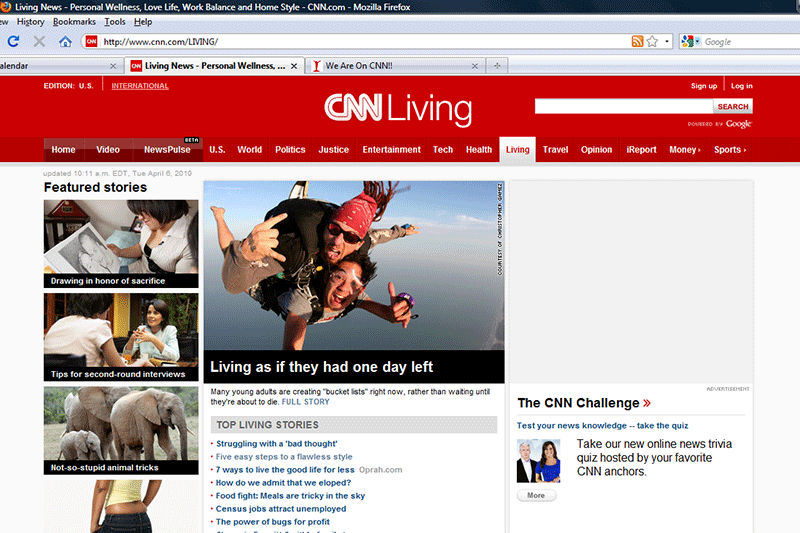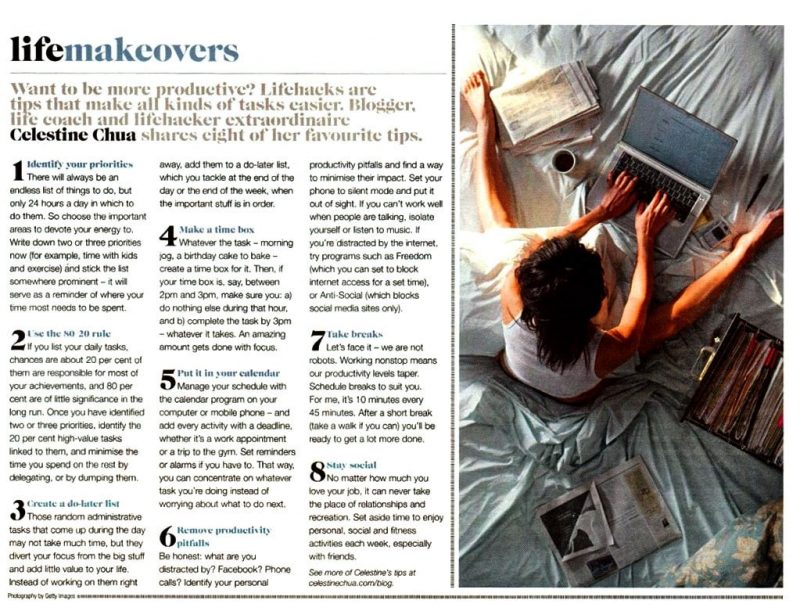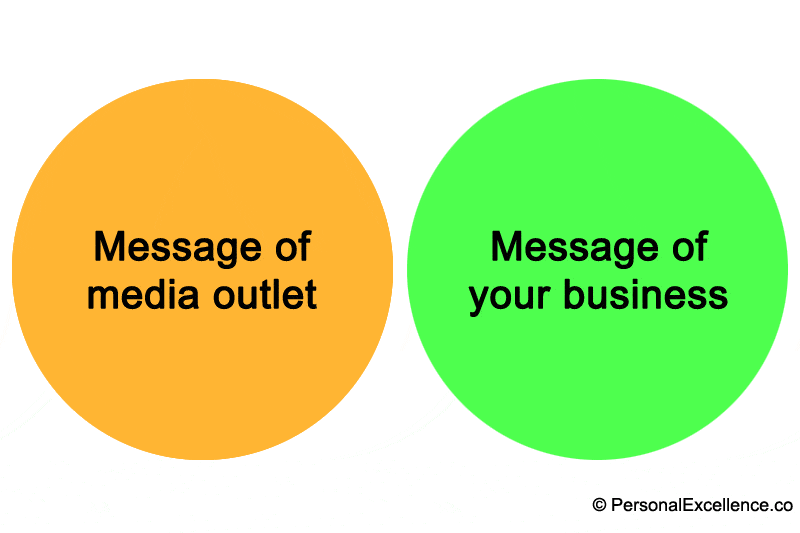
Being featured on CNN, talking about bucket lists and things to do before we die
I often get asked by bloggers and business owners how I get so many media mentions.
In the past few years of starting my business, I’ve been interviewed or quoted nearly 40 times in various media, from newspapers, to print magazines, to TV, to radio, to online media. (These do not include blog interviews.)

My article on Productivity in Australia’s The Sun-Herald (newspaper in Sydney,
published every Sunday) and The Age (Melbourne’s daily newspaper)
The media outlets that have featured me include both international and local outlets, such as CNN International, Cosmopolitan UK, Business Insider, CBS Business Network, Channel News Asia, Simply Her Magazine (including a photoshoot and double page feature), Asia One, Sun-Herald, The Sunday Age, OMY Singapore, The Straits Times, Today, My Paper, Lianhe Zaobao, Lianhe Wanbao, and 938 Live radio. I’ve been on production sets before and I’ve had media representatives at my home before too.

Behind-the-scenes shot of my photoshoot with Simply Her magazine in 2010

Being profiled on Soul Sisters, a documentary featuring inspiring women in Singapore

My interview on Channel News Asia, BlogTV segment (with hosts Divian and Flying Dutchman, on the right)
I truly appreciate all these media opportunities which journalists and editors have provided me. They have allowed me to reach out to more people with my message.
In today’s article, I share tips on how to get (constant) media coverage for your blog, business, or startup. I figure that the information will be highly useful for those of you who want to increase awareness of your work. Unlike what some might think, traditional media still has its reach and audience. The ideas in this article can apply to getting media coverage online too.
How to Get Media Coverage: The Proactive Approach
If you have just started your business, you are totally new in what you do, and you don’t know anyone in the media industry, you have to proactively reach out to the media to get the word out about your business.
The standard way to do this is to write a press release and send it to the media outlet. This process applies to magazines, newspapers, radio shows, and TV segments. I will teach you how to do this in five steps, along with tips to maximize your chances of media pickup in each step.
Step 1: Select Media Outlets that Match Your Message
Every media outlet has its target audience. A business magazine like Forbes likely targets career-driven professionals and business owners reading it. A lifestyle magazine like Simply Her (Singapore magazine) probably targets career-driven women in their 30s who are married with a kid or two. A national newspaper like The Straits Times (Singapore daily) caters to the mass public, with individual sections like World, Business, Finance, Home, Digital, etc. catering to those respective topics.
To maximize your chances of coverage, select media outlets that match the message of your business.
When I started my business, I selected a list of media outlets which had the most relevance to my message (personal development, life, and fulfillment). Among them were lifestyle magazines, newspapers, and a radio segment on entrepreneurship and life. I ignored the outlets that had little relevance to my message, such as food magazines, home decor magazines, and financial journals.
You should take time to research the media outlets in your country (or outside of your country, if you run a global operation) before making your selection.
Don’t neglect the smaller media outlets. I’ve found that it’s significantly easier to get coverage on smaller media outlets than the large names since the former probably (a) gets less news story submissions and (b) has less leverage in getting interviews and quotations from big wigs, which makes them more keen to cover grassroots stories. Target both large and small media outlets.
Step 2: Write Your Press Release
Your press release should include your company logo, company address, contact number, email address, title of the story you want the media outlet to cover (e.g. new product launch, new service launch, story of your business), and a write-up of the story itself. Journalists, editors, and producers will use your release to determine if they want to feature you.
Below are some great resources on how to write a press release, including a press release template, tips on writing press release, and a checklist for your press release. They are pretty self-explanatory so I’ll leave you to read them. I want to focus this guide on strategies and not basic how-to’s.
- Sample Press Release Template
- How to Write a Press Release (Inc.com)
- How to Write a Killer Press Release (Great PDF Guide)
- Simple Checklist for Your Press Release (Business Wire)
Four things to keep in mind as you write your press release:
Tip #1: Identify a Good Story Angle
Most press releases are simple announcements for products or services. It’s the same reason why most of these press releases do not get picked up by the media too, unless the product or service has high relevance among the public (e.g. iPhone 5, Windows 8, MacBook) and/or the company making the announcement is already very well-known in the industry (e.g. Apple, Facebook, Starbucks).
If you are starting out, you wouldn’t have the privilege of a well-known brand name or sturdy credentials, so you have to identify a great story angle for the journalists/editors/producers to want to pick you.
A great story angle should comprise of one or more of the following four factors:
a) Relevant to the Audience
Journalists, editors, and producers will only feature a story if they think it is relevant to their audience. You should find a story that is both relevant to the media outlet and relevant to your business.
Think about this in terms of the venn diagrams below:


Example
Perhaps you want to get on a radio show that covers dating and relationship advice. Topics they cover include what to do on first dates, how to deal with a cheating spouse, and conflict resolution.
On the other hand, you run a family wellness center, where you do coaching, training, and you sell educational products. Topics you cover include parenting advice, spousal advice, and how to achieve work-life balance.
Based on these, the topics that are relevant to BOTH the radio show and your business include: how to resolve conflicts with your spouse, how to keep the romance afloat in a marriage, and how to date when you are a single parent with a child.
It is important that you identify the common message between the media outlet and your business, NOT modify your core message for the sake of getting coverage.
If you get coverage using the latter approach, it wouldn’t be good quality coverage anyway. The readers, listeners, or viewers of the media outlet wouldn’t convert into your customers or readers since your business/blog/startup is not related to the things that drew them to the coverage. You will only receive a burst of interest which quickly tapers thereafter.
b) Sensational Factor (i.e. Is Your Story “Scandalous” Enough?)
At the end of the day, the objective of the media outlet is to get as many readers/listeners/viewers as possible. Sensational topics tend to invite great audience interest, which is why you often see crazy stories in the newspapers like “12-year-old girl gives birth to baby”, “Mom commits suicide after killing kids” and “Bankrupt man becomes millionaire in two years”, or feature stories in magazines like “My rendezvous with a married man with two kids” and “How I lost 40 pounds in 30 days”. Editors lap them up; the audience loves to read them.
Hence, the more sensational your story is, the greater the chance of coverage.
What makes something sensational? Something that contravenes the norm. Something that is totally unexpected. Something that violates normal beliefs and thinking.
You shouldn’t cook up a story just to get a feature (that’s dishonest). Do a brainstorm for story angles that are true to your business/life which are sensational to the audience at the same time. Identify the things that are considered norms in your society, then see if there is anything you can use as a story angle.
Example: One of the story angles which I brainstormed when I started my business (2008) was the fact that I had quit a prestigious, well-paying job to pursue my passion—from nothing. This was considered unconventional in the context of the Singapore society (at that time, at least) because most locals conformed to the view that one should stay in a stable job with financial security and an iron rice bowl—the complete opposite of what I did. Hence, I used that as the angle for one of my press releases, and it was eventually picked up by several media outlets (Today, OMY, Lianhe Zaobao, AsiaOne, among a few other sites).
c) Relates to Current Trends
The more your story angle relates to current trends, the more likely it will be picked up. You can get ideas of what’s current by reading/watching the news and getting yourself up to speed with the past news/magazine publications.
Example: If the latest focus of the government is to encourage its people to get married and you run a relationship coaching service, you can pitch a story that supports the government’s message, while promoting your service at the same time.
Perhaps you found that majority of your single clients remain single because they feel marriage is a burden. When you calculate the statistics, the figure comes up to 60 percent. You can pitch your story as “60% of singles do not wish to get married because they feel marriage is a burden”, then build your press release around that. In writing the story, you would supplement the data and inevitably talk about your business, which would build awareness for your business and your brand.
d) Newsworthy; Announces Something New
Newspapers love breaking news, so if you have something to announce, like a new launch, a new service, or the launch of a new business, that will be a good angle to pitch. (Your story has to be relevant to their audience though.)
Example: When I started PE in 2008 and when I opened the training arm of my business in 2009, I sent out press releases to make the announcements. Each time, the releases were picked up by various media outlets. (I eventually consolidated my training, coaching, and articles under PE’s online platform last year.)
Tip #2: Study Past Stories that were Published to Get Ideas
Since every story in a magazine or newspaper has to be approved by the editor before it gets published and every feature on a radio show or TV show has to be approved by the producer before it goes on air, the features you see in each publication/show would give you a clue on the kind of stories the editor/producer is interested in. Take time to research those past features.
Before I began pitching to the media (back when I started my business), I went to the library, grabbed the past issues of magazines and newspapers, and scanned through them. I took note of the kind of topics each outlet tended to feature. I also tried to identify if there were any trends in the stories. Doing so helped me to understand the editors’ interest areas, which helped me to work out an appropriate story for each media outlet.
Tip #3: Showcase Your Credibility
When writing about your business or yourself in the press release, you should showcase your credentials as much as possible. Why should the media outlet pay attention to you? Why should you be regarded as the expert in this field? What makes your business so great?
Example: Maybe you have five years of experience in this field. Maybe you have worked with over 100 clients on this topic. Maybe you have worked with X, Y, and Z renowned organizations. Maybe you have spent eight years of your life studying this subject. Weave them into the press release.
Your credibility, be it your educational qualifications, professional experience, achievements, or knowledge, will give the story depth.
Tip #4: Customize Your Press Release for the Main Media Outlets
In the employment world, it’s not uncommon to customize your resume for each job you apply to, especially if you’re applying to a specific job in a large corporation. Doing so increases your chances of being selected. Likewise, when writing your press release, customize it for the media outlet you are sending to—especially if it is a significant outlet which you want to be featured in.
Example: If the media outlet is a tech magazine, cater the message to be more tech-centered. If the outlet is a radio segment on entrepreneurship, cater the message to be more entrepreneur-focused.
(Apply the 80/20 rule though—customize your press releases for the 20% biggest media channels you are reaching out to; stick to a standard press release for the rest. Otherwise, it can be very time consuming to customize your press release for every single outlet you send to.)
Step 3: Send Your Press Release
a) Final Check: Proofread and Refinement
Be sure to proofread and ensure there are no mistakes. Run it by Step 2 to ensure that you didn’t miss anything.
b) Get the Contact Details
You can get the contact details of each media outlet from its website. It should have a “contact” section with details on how people can send press releases and news stories. If not, it should list its editors and journalists and the respective departments they are in. Look for their email addresses there.
For magazines, they usually have a page (within the first few pages of the publication, before the content page) that lists all their editors and writers, along with their contact details. You can also find the writer’s name and his/her email address at the end of every article in the magazine.
For newspapers, each article usually starts with the journalist’s name and ends with his/her email address.
c) Send the Press Release!
- Send your press release to the relevant department. If your story is about the launch of your tech startup, you shouldn’t send it to the Beauty, Fashion, or Food departments—you should send it to the Digital, Tech, Business, or Entrepreneur departments. Mass sending your press release to everyone without regard of its relevance to him/her can result in your email address being blacklisted.
- Email each media outlet separately, so that it’s easier to track who you have sent to and who has responded. Moreover, you probably have customized press releases for some media outlets (see Tip #4, under Step 2), which justifies sending individual emails.
- Best time to send your press release is… I don’t have data to back this up, but I recommend to send your press release on Monday morning, right before people come into the office, to maximize your chances of coverage. That’s because news stories are usually determined early in the week. Mornings are when editors scan through their emails to see if there is anything worth covering. Afternoons are when journalists and reporters are out in the field to do interviews.
- When writing the email…
- Use the title of your press release as the title of the email.
- Have a short introduction. In the body text, write a short introduction on who you are, your contact details (email, number, and website address (if relevant)), and one to two line summary of the press release.
- Paste the press release content into the email, below your introduction. Journalists, editors, and producers are busy people. Some of them just want to scan through what your release without opening a document.
- Attach the press release document as a PDF document in the email (just in case they prefer to read it as a PDF).
Step 4: What To Do If Your Story Gets Picked Up (Or Not)
Wait for a response. You can call each media outlet (within the day itself) to check if they have received your release. This is also a contact point to make an impression (amidst the hundreds of press releases they receive weekly).
If your story gets picked up…
If the journalists/editors/producers are interested to feature your story, they will get back within one or two days, usually within the day itself. (Yes, things move fast in the newsroom!) Sometimes they email; most of the times they just call (from my experience).
- If your press release contains all the information they need, they’ll simply call to inquire a few other details.
- If they want to make it a big feature, they will arrange for an in-person interview. It may/may not include a photographer.
- If it involves a photoshoot, you will be invited to their studio.
- If it’s a show, like a radio show or TV show, they will arrange a suitable date/time with you and the topic they would like you to speak on.
Your feature can go up as soon as the next day, later in the week, or a few weeks later, depending on how newsworthy your story is and whether they have pressing news to publish in the interim.
If your story does not get picked up after a week…
- Send the release again. Specify in the email that you had sent this release a week ago (insert date) and you are sending it again just in case he/she did not receive it. (Send only one followup. If the person doesn’t respond even after your followup email, you can take that as a rejection.)
- Try a different contact. There are many journalists, editors, and producers for each media outlet. Just because one contact doesn’t pick up your story doesn’t mean the entire media outlet is not interested in it. Once, I submitted a story to a local daily which didn’t get picked up. After a few days, I submitted the same press release to a different department, which got picked up. Try different contacts; don’t stop at the first person.
If your story does not get picked up even after resending…
It would be one of the following reasons (assuming your email was received and read):
- Your story is not relevant enough to the media outlet.
- Your story is not sensational enough.
- Your story is not newsworthy enough.
- You lack the credibility to give the story depth.
Don’t be disheartened though. Every media outlet receives many news pitches every day, so its editors/producers need to be choiceful in the stories they select. If you are a new startup with no credentials to speak of and an average product proposition, it can be an uphill battle getting coverage; if you’re trying to get coverage on a popular media outlet like CNN or New York Times, it’s virtually impossible unless you have a flying monkey that can bake cookies.
Here’s what you can do:
- Try again after a month or two. Go for a new story angle. Get back to the drawing board and work through Step 2 again. Study the stories that are published in each media outlet and understand why these stories were chosen over yours. Then, apply these lessons in your next release.
- Build your credentials by working on your business/blog/startup. Submit a new press release after six months or more, when your business/blog/startup is considerably bigger and more credible.
- Submit a new press release when you have something new to announce. Try again when you have a new product launch, a new service launch, or new news to share.
Pace yourself. Don’t submit press releases every month if you have nothing substantial to announce. It may result in your email and business being blacklisted by the media outlet.
Step 5: Maintain Good Media Relations
After your feature, maintain contact with the journalist/reporter/editor/producer. Let him/her know your areas of expertise and your interest to contribute/be interviewed for future stories.
Follow-up every couple of months to see if they have stories which you can contribute to. Many interviews I get today are with journalists/reporters who interviewed me for past features.
When you meet a new media personnel, understand his/her work scope to see if there is anything you can contribute to his/her articles/stories/publication/show. If the person is keen, you can usually work something out.
At the end of the day, build genuine relationships. Don’t befriend someone just because he/she works in the media; befriend him/her because you want to make a connection.
How to Get Media Coverage *Constantly*: The Real Deal
I think writing press releases whenever you have a newsworthy story is important as it helps to break the story faster. Maintaining good media relations is absolutely important as the media is an important part of any good marketing campaign.
Ultimately though, what I feel is the most crucial factor in ensuring ongoing media coverage is to simply be incredible in what you do. By that, I mean…
- Be the best in your field. Develop the fastest growing startup, have the largest customer base, have the highest readership, have the highest rated customer satisfaction levels, have the most innovative products/services, run the biggest business in the world, etc. Be regarded as the best of the best in your field, by virtue of your business performance, your business reputation, your knowledge, your experience, and your ability. Read: Successful Businesses Interview Series
- Have a great message to share. What is your reason for being? What do you want to share with the world? What do you want others to take away when they meet you / interact with you? Read: Discover Your Purpose (6-part series)
- Live a great life. Set your goals and live your dreams. Don’t put things on hold. Have a great values system. Be true to yourself. Keep working on being a better person. Most importantly, live your life. Read: 101 Ways To Live Life To The Fullest
When you are the best in what you do, you have a great message to share, and you have an aspirational life, you will naturally become a media magnet. Ever heard of Mark Zuckerberg, Lady Gaga, Justin Bieber, the Kardashians, Oprah Winfrey, Maria Sharapova, or Katy Perry having to approach the media to get some coverage? Yeah, I didn’t think so either. The media follows these people and covers them regularly because the audience wants to read about them. That’s because they are so successful and accomplished in their own right.
Besides the two times where I sent out press releases (one time when I first launched PE in 2008; second time when I set up my training arm in 2009), I’ve never actively solicited for media coverage. All the interviews and features I had gotten since then, about three-quarters of them, have been initiated by the journalists, reporters, or producers themselves, who knew about me from various sources (such as search engines, past clients, word of mouth and past interviews). They decided to approach me because they felt that I had something valuable to offer to their stories or shows.
I think unsolicited media coverage is definitely better than actively solicited coverage since you don’t have to take time (or hire someone) to write a press release and subject yourself to the mercy of the editor/producer. It is a better long-term strategy.
This is why I focus my effort on building my business, becoming a better person, and living a great life; I know that when I have a large platform, great content and great value to share, people will naturally follow what I do. There is still merit in writing press releases and sending them; it’s just that it shouldn’t be the only thing you think about and do all-day long.
Final Word: Media Only Serves as a Awareness-Driving Tool; It Is Not the End in Itself
In case you think that your business will skyrocket to international fame and you can sit back, relax, and do nothing after getting the coverage, think again. It doesn’t work that way.
In most cases, you will get a spike in traffic (if you run a site) and/or interest in your service on the day your story is featured. The larger the media outlet and the more prominent your feature, the bigger the spike. If the media outlet has a small circulation, listenership or viewership and/or the feature is only a small mention, you’ll only get a small trickle of traffic/interest (if anything at all).
This increase in traffic and interest will taper almost immediately after that. Within a few days to a week, things will be back to how they were before you received the coverage.
Sure, getting media coverage is a great way to boost awareness for your work, no doubt about that. It may get you a few leads. It may get you a few new loyal customers. It may help you sell a few more products than usual.
But the story doesn’t end after you get one media coverage. It doesn’t end after you get two, five, 10, or even 50 media features. The media simply serves as a platform to spread the word about your business, no more, no less. It’s not an end in itself. It will not make you achieve international fame (unless you get one full reality TV series like the Kardashians did; even then they continued to be famous for their lifestyles, personalities, and family stories). It will not make your products fly off the shelf by themselves.
At the end of the day, you still need to put in the hard work to grow your business. Having a great business acumen, developing a great product proposition, identifying outstanding strategies, doing things that others don’t want to do, and working overtime. These are some of the many things that are necessary to excel, not just in the business world or in blogging, but in life.
For new business owners, the Successful Businesses Interview Series has great tips on how to build a successful business.
Share this Guide!
I hope you’ve found this guide useful! It stands at a hefty length of 4,200+ words and is definitely crucial for those of you who want to get constant media coverage (for your business/blog/startup).
If you’ve found this guide helpful or if you think it’s something others can stand to gain from, please do me a favor—link it on your website/blog and share it on your social media channels. It’ll inspire me to write more resources like this and share more of my great strategies with all of you. Thank you!






![How To Deal with Backstabbers? [Video]](https://personalexcellence.co/files/celestv-backstabbers-200x133.jpg)


 Thanks for reading. If you like my free articles, join my private email list and get my latest updates and articles sent right to your inbox.
Thanks for reading. If you like my free articles, join my private email list and get my latest updates and articles sent right to your inbox.